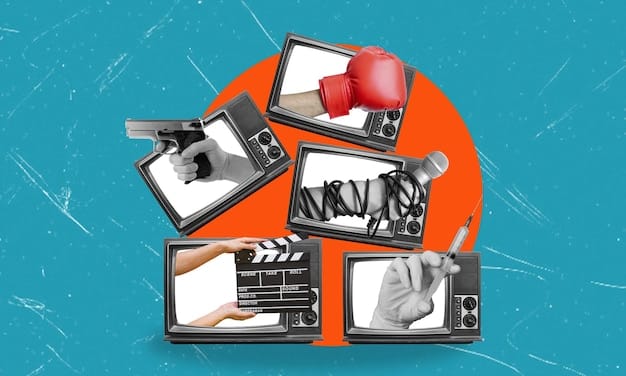Streaming in 2025: How Movie Release Dates are Changing

The landscape of movie release dates is undergoing a significant transformation due to the increasing influence of streaming services, impacting traditional theatrical windows and creating new opportunities and challenges for both filmmakers and audiences by 2025.
The way we experience movies is rapidly evolving. Understanding how streaming services are changing movie release dates in 2025: what you need to know now is crucial for both movie enthusiasts and industry professionals.
The Rise of Streaming and Its Impact on Theatrical Releases
The dominance of streaming platforms has undeniably reshaped the entertainment industry. This shift has led to a re-evaluation of traditional theatrical release models and has had a ripple effect across the entire movie ecosystem.
The Diminishing Theatrical Window
Historically, movies enjoyed an exclusive theatrical window, meaning they were only available in cinemas for a considerable period before being released on other platforms. Streaming services are significantly compressing this window.
Day-and-Date Releases: A New Normal?
Some studios are experimenting with day-and-date releases, where movies are available in theaters and on streaming platforms simultaneously. This approach offers convenience to viewers but also raises concerns about the long-term viability of cinemas.

The change in release dates has already been proven to be a success for platforms like Netflix and Prime Video. Services like these are paving the way for a new normal in the movie industry.
- Reduced Exclusivity: The traditional 90-day theatrical window is becoming a thing of the past.
- Consumer Choice: Viewers now have more control over how and when they watch movies.
- Increased Accessibility: Streaming offers access to a wider range of films, especially for those who may not have easy access to cinemas.
In conclusion, the rise of streaming is fundamentally altering the theatrical landscape, challenging established norms and creating new opportunities. This trend is expected to continue and even accelerate by 2025.
The Economic Implications for Studios and Theaters
The changing release strategies have substantial economic consequences for both movie studios and traditional theater chains. New revenue streams and challenges are emerging, reshaping the financial dynamics of the movie industry.
Impact on Box Office Revenue
Shorter theatrical windows and day-and-date releases can impact box office revenue. While some viewers may still choose to see movies in cinemas, others may opt for the convenience of streaming at home.
New Revenue Streams for Studios
Streaming services offer studios new revenue streams through subscription fees and digital rentals. This can offset potential losses from reduced box office returns.
- Subscription Models: Recurring revenue from streaming subscriptions provides a stable income source.
- Digital Rentals and Purchases: Studios can generate additional revenue through digital sales and rentals.
- Data Analytics: Streaming platforms provide valuable data on viewer preferences, helping studios make informed decisions about content creation and distribution.
While studios can benefit economically through new revenue streams, theaters have to adapt. Theaters now are trying new formats to offer a differentiated product from the stay-at-home experience.
In conclusion, that’s why these economic shifts require both studios and theaters to adapt and innovate to thrive in the evolving entertainment landscape.
The Impact on Independent Films and Filmmakers
The shift in release dates affects not only blockbuster releases but also has a nuanced impact on independent films and filmmakers. The changing landscape presents both opportunities and challenges for smaller productions.
Increased Visibility on Streaming Platforms
Streaming services can provide independent films with a wider audience reach than traditional theatrical releases. Smaller productions can gain visibility and recognition through curated collections and platform recommendations.
Challenges in Securing Theatrical Distribution
The focus on streaming releases can make it more difficult for independent films to secure traditional theatrical distribution deals. This can impact their ability to generate buzz and critical acclaim.

The film industry is taking note on how it’s important to promote independent films on platforms that have a broad audience reach.
- Direct-to-Streaming Releases: Independent filmmakers can bypass traditional distribution channels and release their films directly on streaming platforms.
- Niche Audiences: Streaming allows independent films to reach specific niche audiences that may not be served by traditional cinemas.
- Lower Marketing Costs: Streaming platforms often provide marketing support for independent films, reducing the burden on filmmakers with limited budgets.
In conclusion, the impact on independent films is multifaceted, with streaming platforms offering increased visibility but also posing challenges to traditional distribution models.
Changing Consumer Behavior and Viewing Habits
The availability of movies on streaming services is influencing how audiences consume content, leading to shifts in viewing habits and preferences. These changes are reshaping the dynamics between studios, theaters, and viewers.
The Rise of Home Entertainment
Streaming has fueled the rise of home entertainment, with viewers increasingly opting to watch movies from the comfort of their own homes. This trend has been accelerated by advancements in home theater technology.
Binge-Watching and On-Demand Viewing
Streaming services encourage binge-watching and on-demand viewing, allowing viewers to consume content at their own pace and schedule. This has led to a shift away from traditional linear television viewing.
Platforms also play a role in how the consumer views content as they curate videos for specific audiences.
- Convenience and Accessibility: Streaming provides convenience and accessibility, allowing viewers to watch movies anytime, anywhere, on any device.
- Personalized Recommendations: Streaming platforms use algorithms to provide personalized recommendations based on viewing history and preferences.
- Cost-Effectiveness: Streaming subscriptions can be more cost-effective than purchasing individual movie tickets or DVDs.
In conclusion, the changing consumer behavior is reshaping viewing habits and preferences. The film industry adapts its strategy to meet consumer demands.
The Future of Movie Theaters in a Streaming World
The increasing prevalence of streaming raises questions about the long-term viability of movie theaters. While cinemas may face challenges, they also have opportunities to adapt and remain relevant in the evolving entertainment landscape.
Enhanced Cinema Experiences
To compete with streaming, movie theaters may need to focus on providing enhanced cinema experiences, such as premium seating, immersive sound systems, and gourmet food and beverage options. These kinds of experiences are drawing crowds to the theatre.
Community and Social Engagement
Movie theaters can serve as community hubs, offering social experiences that cannot be replicated at home. Special events, film festivals, and Q&A sessions with filmmakers can attract audiences seeking a sense of community.
- Niche Programming: Theaters can differentiate themselves by offering niche programming, such as classic film screenings, independent film showcases, and foreign film festivals.
- Interactive Experiences: Some theaters are experimenting with interactive experiences, such as immersive screenings and virtual reality tie-ins.
- Partnerships and Collaborations: Theaters can partner with local businesses and organizations to offer unique events and promotions.
In conclusion, the future of movie theaters in a streaming world depends on their ability to adapt, innovate, and provide unique experiences that cannot be replicated at home.
Strategies for Adapting to the New Release Landscape
With the continuous changes for how movies are released, studios, filmmakers, and exhibitors must adopt new and innovative strategies to navigate the evolving landscape successfully.
Flexible Release Models
Studios may need to adopt more flexible release models, such as staggered releases, hybrid releases, and exclusive streaming windows. These is a more complex but needed transition.
Data-Driven Decision-Making
Data analytics can play a crucial role in informing release strategies and marketing campaigns. Studios can use data to identify target audiences, optimize pricing, and measure the effectiveness of different release models.
With this in mind here are points to consider with data-driven decision-making.
- Targeted Marketing: Studios can use data to tailor marketing messages to specific audience segments, increasing the efficiency of advertising campaigns.
- Dynamic Pricing: Data can be used to adjust ticket prices based on demand, maximizing revenue for both studios and theaters.
- Content Optimization: Streaming platforms can use data to identify which types of content resonate with viewers, informing future content creation decisions.
In conclusion, by embracing flexible release models, data-driven decision-making, and collaborative partnerships, stakeholders can navigate the new release landscape and thrive in the streaming era.
| Key Point | Brief Description |
|---|---|
| 🎬 Streaming Impact | Streaming changes theatrical release norms. |
| 💰 Economic Shifts | Studios gain streaming revenue; theaters adapt. |
| 🌱 Indie Films | Streaming boosts visibility, poses distribution challenges. |
| 📺 Viewing Habits | Home viewing rises with personalized streaming. |
FAQ Section
▼
Streaming services are shortening the traditional theatrical window, leading to quicker availability of movies at home. This benefits the viewers who prefer to watch on-demand.
▼
Day-and-date releases are when a movie is available in theaters and on streaming platforms simultaneously. This model offers viewers immediate access but impacts theaters.
▼
Streaming services give independent films broader visibility than traditional releases. They can reach niche audiences through diverse platform offerings, providing marketing support as well.
▼
To stay viable, theaters can enhance experiences, offering premium seating, sound, and gourmet options. Community events, film festivals, and partnerships can also draw audiences.
▼
Strategies involve flexible releases, such as staggered or hybrid models. Data-driven decisions help target audiences, optimize pricing, and boost marketing, ensuring better profits.
Conclusion
The evolving movie landscape is undergoing a complex transformation with streaming services increasingly influencing release dates. Navigating these changes requires flexible strategies, data-driven decisions, and a focus on enhancing the viewing experience for both studios and consumers. By adapting to these shifts, stakeholders can thrive in the dynamic future of entertainment.